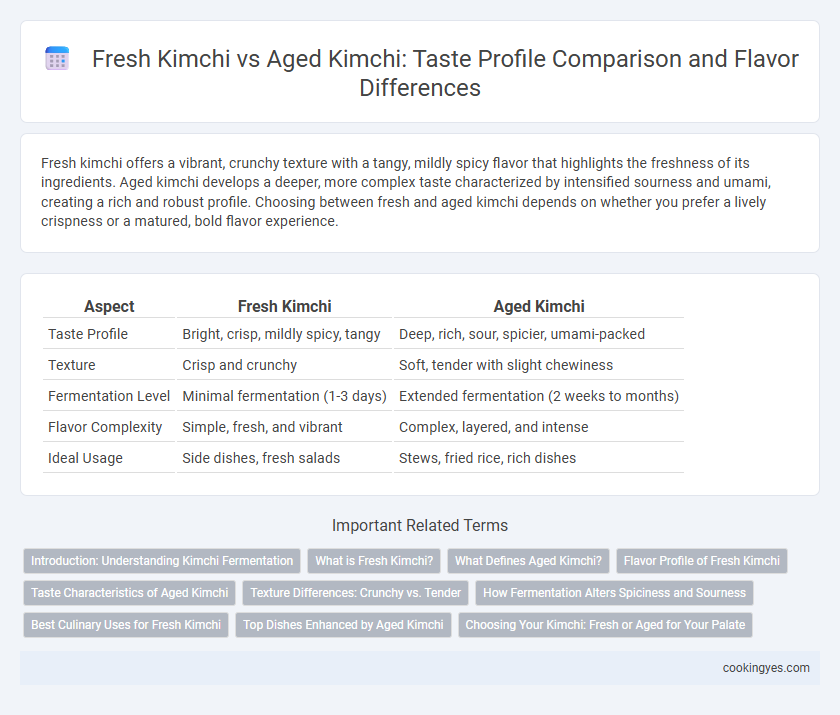Fresh kimchi offers a vibrant, crunchy texture with a tangy, mildly spicy flavor that highlights the freshness of its ingredients. Aged kimchi develops a deeper, more complex taste characterized by intensified sourness and umami, creating a rich and robust profile. Choosing between fresh and aged kimchi depends on whether you prefer a lively crispness or a matured, bold flavor experience.
Table of Comparison
| Aspect | Fresh Kimchi | Aged Kimchi |
|---|---|---|
| Taste Profile | Bright, crisp, mildly spicy, tangy | Deep, rich, sour, spicier, umami-packed |
| Texture | Crisp and crunchy | Soft, tender with slight chewiness |
| Fermentation Level | Minimal fermentation (1-3 days) | Extended fermentation (2 weeks to months) |
| Flavor Complexity | Simple, fresh, and vibrant | Complex, layered, and intense |
| Ideal Usage | Side dishes, fresh salads | Stews, fried rice, rich dishes |
Introduction: Understanding Kimchi Fermentation
Kimchi fermentation transforms fresh kimchi's crisp, vibrant flavors into the complex, tangy, and umami-rich profile characteristic of aged kimchi. The fermentation duration and temperature influence lactic acid bacteria growth, altering the kimchi's texture and taste intensity. Fresh kimchi offers a crunchy, mildly spicy taste, while aged kimchi develops deeper sourness and richness favored in traditional Korean cuisine.
What is Fresh Kimchi?
Fresh kimchi offers a crisp texture and a vibrant, tangy flavor profile rich in lactic acid bacteria, providing a refreshing balance of spiciness and natural vegetable sweetness. It is typically consumed within a few days of fermentation when the cabbage remains firm and the taste is bright and mildly pungent. This early stage of fermentation highlights the fresh, lively flavors and is preferred for salads or lighter dishes that emphasize fresh vegetable crunch.
What Defines Aged Kimchi?
Aged kimchi is defined by the fermentation process that allows the cabbage and seasonings to develop deeper, more complex flavors and a softer texture compared to fresh kimchi. The aging period, typically ranging from several days to weeks, enhances the tanginess and umami notes due to the activity of lactic acid bacteria converting sugars into organic acids. This fermentation not only intensifies the sourness but also mellows the spiciness, creating a balanced, rich taste profile characteristic of aged kimchi.
Flavor Profile of Fresh Kimchi
Fresh kimchi offers a vibrant and crisp flavor profile characterized by bright, tangy notes and a pronounced crunch from freshly fermented vegetables. The taste is mildly spicy with a refreshing balance of garlic, ginger, and chili, making it less pungent compared to aged kimchi. This freshness highlights the natural sweetness of Napa cabbage and provides a lively, zesty experience ideal for those seeking a clean, sharp flavor.
Taste Characteristics of Aged Kimchi
Aged kimchi develops a rich, tangy flavor profile with pronounced sourness and deep umami notes, resulting from extended fermentation. The texture becomes softer yet retains a pleasant crunch, enhancing its complexity. This maturation process intensifies probiotic content and creates a robust, savory taste favored in traditional Korean cuisine.
Texture Differences: Crunchy vs. Tender
Fresh kimchi offers a vibrant crunch with crisp Napa cabbage leaves delivering a refreshing bite, while aged kimchi transforms into a tender, softer texture as fermentation breaks down fibrous components. The crunchiness in fresh kimchi enhances a lively, invigorating eating experience, contrasting with the rich, mellow mouthfeel of aged kimchi. Texture differences significantly influence flavor perception, where fresh kimchi's firmness accentuates spicy and tangy notes, and aged kimchi's softness deepens umami and complexity.
How Fermentation Alters Spiciness and Sourness
Fresh kimchi features a vibrant, crisp texture with a pronounced spicy heat driven by fresh chili peppers and garlic, while aged kimchi develops a deeper, more complex flavor characterized by heightened sourness and mellowed spiciness due to extended lactic acid fermentation. During fermentation, beneficial lactic acid bacteria convert sugars into organic acids, increasing acidity and reducing sharp spiciness, resulting in a tangier, softer taste. The balance between spicy heat and sourness shifts progressively, making aged kimchi preferred for richer, more nuanced culinary applications.
Best Culinary Uses for Fresh Kimchi
Fresh kimchi features a crisp texture and a vibrant, tangy flavor with pronounced garlic and chili notes, making it ideal for dishes that benefit from a lively, refreshing taste. Its bright acidity and crunch complement salads, stir-fries, and bibimbap, enhancing freshness without overpowering other ingredients. Chefs prefer fresh kimchi for recipes requiring brief cooking or raw applications to preserve its complex, pungent qualities.
Top Dishes Enhanced by Aged Kimchi
Aged kimchi offers a deeper, tangier flavor profile compared to fresh kimchi, enriching dishes with complex umami notes and subtle sourness. Top dishes enhanced by aged kimchi include kimchi jjigae (stew), kimchi fried rice, and kimchi pancakes, where the fermented taste intensifies the overall depth and warmth. The prolonged fermentation process of aged kimchi boosts probiotics, contributing to both flavor and health benefits in traditional Korean cuisine.
Choosing Your Kimchi: Fresh or Aged for Your Palate
Fresh kimchi offers a crisp texture with vibrant, tangy flavors and a mild spice level that enhances its refreshing quality. Aged kimchi develops deeper umami notes, a pronounced sourness, and a softer, fermented texture, enriching dishes with complexity. Selecting between fresh or aged kimchi depends on your palate preference for either bright and lively or robust and savory taste profiles.
Fresh Kimchi vs Aged Kimchi for taste profile Infographic

 cookingyes.com
cookingyes.com